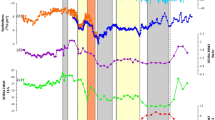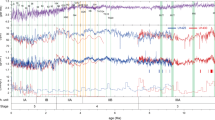Abstract
We studied the volcanic contribution to the global sediment budget in the Pacific Ocean basin. It is the world's oldest (174 m.y.) and largest (≈49% of Earth's surface area) ocean basin and has had a high and continuous tephra influx from intraplate and convergent margin volcanoes through time. Computerized shipboard data from 65 legs of the Deep Sea Drilling Project (DSDP) and the Ocean Drilling Program (ODP) were screened for the presence of volcaniclastic components. Tephra-bearing and tephra-free core sections (standard 1.5- and 0.30-m core catcher sections) were separated, regardless of the mass fraction of tephra present. The percentage of tephra-bearing core sections ("tephra frequency") per site and time span ("age unit") was calculated. The age units were the Quaternary, the subepochs of the Tertiary, and the stages of the Cretaceous. A total of 424 drill sites yielded 1433 usable stratigraphic units. Fifty percent are younger than 13 m.y., corresponding to only approximately 10% of the total interval studied (124.5 m.y.). The percentage of tephra-bearing age units is high throughout (83±6%) and correlates linearly with the total number of age units (R 2=0.998; n=17). The average tephra frequency (30–50%) fluctuates, because the abundance of age units of different tephra frequency classes (0, 1–33, 34–67, 68–100% tephra frequency) varies with time. This indicates that the Cenozoic increase in tephra production results from increase in volcanicity and not spatial extension of volcanic source areas. The Cenozoic sediments that were recovered are dominated by distal tephra from explosive arc volcanism. Pulses of arc volcanism occurred in the Pliocene–Quaternary (since ≈5 m.y.) and mid-Miocene (≈12–15 m.y.). However, the record of explosive arc volcanism in Paleogene and Cretaceous sediments was either not drilled or has been destroyed by subduction. Except for the Cretaceous (≈70–110 m.y.) volcanic pulse, intraplate volcanism is poorly represented in the tephra record because the drill sites are outside the proximal range (>500–1000 km) of the sources. Thus, the tephra record drilled contains significant gaps that bias the estimate of tephra volume towards the less voluminous distal deposits. Most of the volcaniclastic volume accumulated by mass wasting as volcaniclastic aprons surrounding ocean island volcanoes. Volcaniclastic production rates range from 10,000 to 41,800 km3/m.y. for large intraplate volcanoes and approximately 10–13 km3/km arc length per million years for oceanic island arcs. Extrapolation over the lifetime of major Pacific arcs and hotspot chains, combined with a volume estimate of the distal tephra component, indicates a minimum of 9.3×106 km3 of tephra, corresponding to 23 vol.% of the existing Pacific oceanic sediments. At least two thirds of the tephra volume was deposited in the proximal range and at least half of it is derived from intraplate sources. The large proportion of tephra, its composition, and its localized accumulation causes significant spatial and temporal variation in Pacific oceanic sediments that should have a perceptible impact on the elemental fluxes between ocean, crust, and mantle.
Similar content being viewed by others
Author information
Authors and Affiliations
Additional information
Received: 7 October 1998 / Accepted: 30 September 1998
Rights and permissions
About this article
Cite this article
Straub, S., Schmincke, H. Evaluating the tephra input into Pacific Ocean sediments: distribution in space and time. Geol Rundsch 87, 461–476 (1998). https://doi.org/10.1007/s005310050222
Issue Date:
DOI: https://doi.org/10.1007/s005310050222




